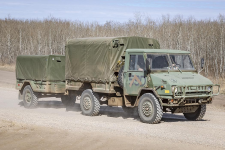National Post ePaper offers current issues of National Post ePaper.

epaper.nationalpost.com
Watchdog says lack of domestic production hamstringing military
National Post - 10 Jun 2023 - Bryan Passifiume
PARLVUParliamentary Budget Officer Yves Giroux appeared before the house national defence committee on Friday.
Canada’s continued reliance on foreign military procurement, as well as an inefficient doubling- up of purchasing authority, is hamstringing Canada’s ability to meet defence targets, says Parliament’s budget watchdog.
Parliamentary Budget Officer Yves Giroux appeared before the house national defence committee Friday morning to provide insight on recent reports on Canada’s defence policy — including his office’s October 2022 report on life cycle costs of Canada’s Canadian Surface Combatants ( CSC) shipbuilding initiative, their June 2022 analysis of Canada’s attempts to meet NATO’S two per cent defence spending benchmark, and its March 2022 examination of planned capital spending under Canada’s Strong, Secure, Engaged (SSE) defence policy.
Regarding the latter report, Giroux said he determined the government was underspending with respect to what was outlined in current defence policy, to the tune of $ 8 billion over four years. “The government, at that point when we released that report, had revised its capital expenditures to make up for that shortfall,” he told the committee.
PBO analyst Christopher Penney told the committee that 2022- 23 saw capital spending shortfalls of $ 1.5 billion compared to what was outlined in Strong, Secure, Engaged — with shortfalls this fiscal year of around $4 billion.
“There was over $ 10 billion planned spending under SSE for 2023/24, and only $6 billion was asked for in the estimates,” Penney said.
Responding to questions from Liberal committee member Darren Fisher on how best to streamline military procurement, Giroux said Canada’s smaller-than-average homegrown defence production base is having a negative impact — particularly when paired with policies favouring procurement from local vendors.
“Right there we’re at a disadvantage, especially if we insist on having Canadian- made major equipment — and the government, for obvious reasons, often insists on domestic production,” Giroux said. “That severely limits the competitive base on which the government can tap.”
Giroux said there’s definite value in having a domestic defence production capacity — but warned against policies that make Canada overly reliant on local production when more cost- efficient options exist overseas. “It’s difficult to meet all of the constraints if you also add domestic production,” he said.
The only way to square that circle, he said, is to make commitments to source domestically with benchmarks to allow for foreign procurement if the numbers don’t make financial sense.
“But then that would be in breach of domestic production capacity policy, and that would leave Canada exposed to foreign suppliers in case of a war outbreak that would require significant ramp- up of production,” he said.
Juggling competition with speed, expediency and financial prudence, Giroux said, requires a “delicate balancing act” between cost and value for money, “while also ensuring, as had been the government’s policy for some time now, to develop a domestic defence capability,” he said. “It’s one thing to procure major equipment from abroad, but in the case of war, it doesn’t guarantee us that we’ll be first to be served — we’d probably be at the back of the queue.”
Streamlining procurement, Giroux said, could be achieved by single points of both contact and accountability. “Right now there’s at least two departments involved — defence and PSPC ( Public Service and Procurement Canada,)” he said. “That would be one way to simplify things, having one person and one organization ultimately accountable for military procurement.”
Last June, National Post reported that Canada slipped further away from NATO’S two per cent funding commitment, putting this country’s defence spending at 1.27 per cent of GDP in 2022 — down from 1.36 per cent the previous year.
In addition to the usual expenditures of an active and functioning military, Giroux said Canada’s defence spending calculations to meet that benchmark include additional items — some Giroux said he found both surprising and unsurprising.
In line with reforms introduced by NATO in 2018, those additional items include military, civilian and veterans’ pensions, certain expenditures by the RCMP, spending by Canada’s coast guard, and limited transfer payments to NATO and other international organizations — in all adding around $ 5 billion to Canada’s defence spending.
Conservative Cheryl Gallant, who asked Giroux about these additional items, noted “The word is that two per cent will become the minimum as opposed to the aspirational two per cent that Canada has taken it to be.”





